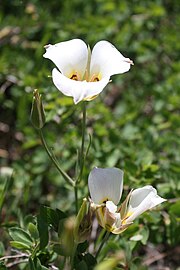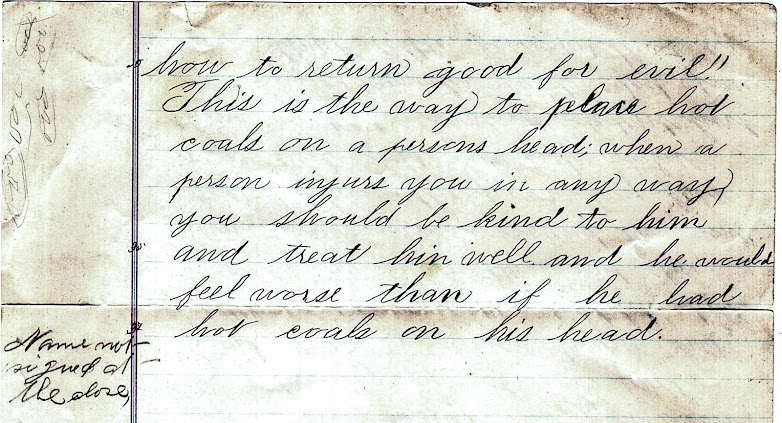TWENTY-FOURTH OF JULY
Talula Nelson
Mt. Pleasant, Utah
The Twenty Fourth of July was always a gala day in the early history of Mt. Pleasant.
At sunrise, the flag was raised on the historic liberty pole.
It was worth rising early to see the men
thread the rope through the pulleys and
see the flag ascend smoothly and surely to the top of the high
pole.
We would recall how a lumberman, Niels Rolfson, had brought this long straight tree down from the
mountains.
What a piece of engineering to guide it safely down the steep slopes and deep canyons!
At
times it would have to be raised by hand almost perpendicularly to make the quick u-turns and miss the
trees that lined the road.
The team of horses had to be held at tight reins to ensure slow movement.
When it finally arrived at the corner of State and Main it was raised by block and tackle
and secured in its
upright position by pegs and props.
An iron band was placed around it to fasten the pegs. Pulleys were
then fastened to the top and bottom to raise the flag.
At ten o’clock in the morning, the grand parade would begin.
The streets had been lined for hours
with people waiting for the wonderful display of floats, beautiful girls, and horses.
Someone would shout,
“Here they come,” and we would all rush to the edge of the sidewalk,
and sure enough, Uncle Sam, tall and
stately in his red, white, and blue could be seen prancing down the street.
For years Elija McClleham led
the parade in his gorgeous costume.
His six feet, seven inches was topped with a high stove-pipe hat,
which added to his height.
His long legs were made to look longer in the red and white striped pants.
The
blue coat with large brass buttons was crowned with a
silk star-studded hat of blue, with white stars and a
red and white striped brim.
He carried a cane, which added to his high-stepping, as he kept time with the
drum or band which followed.
The beautiful Goddess of Liberty, her special white float drawn by six white horses,
well-groomed
and decorated with white pompoms, came into view.
The float, a hayrack done in white bunting, carried a
beautiful young
lady dressed in white with a crown of gold,
and her two lovely attendants. The majestic
title, Miss Liberty,
completed the breathtaking pageant.
Miss Utah followed. Her float
was decorated in red, white, and blue bunting.
The word “Utah” on
her crown, and the presence of her two attendants
seated by her completed the gorgeous float drawn by
four bay horses decorated in red pompoms.
The 13 original states were represented by 13 lovely ladies all dressed in white
and carrying a torch
to signify our beginning as a nation.
Their float was appropriately decorated and drawn by a team of gray
horses, which were decorated with torches to match.
Miss Mt. Pleasant brought many
“oos” and “awes” as her lovely float, drawn by four horses, made its
way into view. She was attended by several lovely girls with banners across their shoulders.
All were proud
to represent their beautiful city.
Miss Sanpete
brought a good laugh as she came riding on a donkey decorated in carrots.
Carrots
were all over, hanging on the bridle and saddle. Her crown was carrots, and a great corsage of carrots
completed her dress.
Following Miss Sanpete came the other 28 counties, represented by 28 young ladies, all riding
horses, their county banners across their shoulders.
Utah’s best crop, a hayrack loaded with primary children, was exciting for the children and parents
alike.
Scenes from the bible were displayed by other church organizations.
The Gleaners were well
portrayed by three women bent over among sheaves of corn and wheat. Jacob’s well and Moses in the
bulrushes was cause for much hand-clapping as the wagons bearing these precious messages moved on.
Indians added a great deal of color as their wagons came along. Their bright shawls and black braids
could be seen among the willows near a three-pole wiki-up.
The Gold Dust Twins clowned along beside the parade. Old Dutch Cleanser came in her red and
yellow dress, stepping the full width of her wide skirt and carrying her stick to fight dirt.
Following, came a long line of covered wagons drawn by oxen. Their wagons were loaded with
children poking their heads out from under the cover;
Mother and Dad were seated in the spring seat, a
small child between them. Outside were boxes of chickens fastened to their wagon.
Others led a cow, and
small pigs could be seen in their boxes. Calves and colts ran to and fro beside their mothers.
Azel Peel always had a team of cows trained to pull his wagon.
Charley Peterson (“Shoemaker,” as
he was called, to distinguish him from others by the same name) hitched a cow and horse together,
much
to the delight of the viewers.
Indians would attack in mock battle.
They would come out of nowhere, shouting, yelling, and riding
wild into the covered wagons.
Nephi Gunderson, dressed as an Indian with war paint and feathers, rushed up to a wagon where his
fiancée, Marie Hansen, was riding; grabbed her, at least tried to get her.
He found a nineteen-year-old girl
quite a handful. She cooperated and rode off with the Indians among much laughing and screaming by the
crowd.
After the parade, a meeting was held in the chapel. This was a very special meeting, where so many
stories of pioneer experiences were told. “Come, Come Ye Saints” and “The Spirit of God Like a Fire is
Burning” were sung by the audience.
“Utah, We Love Thee” was always a special solo. The band played
the “Star-Spangled Banner”, and we all stood while they played.
Then the closing prayer was offered.
The park where the old fort stood was alive after the program. Here many brought picnic lunches,
and a pleasant hour was spent visiting.
Finally, the Bishop came with a bag of coins, and the time had come
for the races. What fun! Foot races, sack races, tugs of war, and climbing the greased pole!
A young pig
was greased and turned loose for anyone who cared to chase him. The one who caught and held on to him
earned the pig.
The park became a ball ground for the men while the women and children retired to the
social hall for a children’s dance.
Later in the evening, after the chores were done and the children put to
bed, the married folks went to the social hall, where they danced and ate till the wee hours of the morning.
Occasionally, the twenty-fourth was celebrated in the mountains.
This was a day long to be
remembered. After the flag-raising and gun powder was set off in Wilson’s Blacksmith Shop,
the wagons
started to roll toward the mountains to Derfee’s Meadows. There, on this beautiful smooth meadow, the
wagons formed a circle similar to the pioneers’ as they crossed the plains.
After the horses were taken into
the trees, fed, and taken care of, fires were started in the hole prepared for Dutch ovens.
The mothers
were well prepared with spring chickens, young carrots, green peas, and new potatoes, which were soon
stewing under the watchful care of the menfolk. Sourdough biscuits were baked, and the picnic was ready.
Gooseberry and rhubarb pies were in abundance. Many preferred another scone dripping with fresh butter
and honey.
Good food with fresh mountain air made enormous appetites.
Balls and nipkats made their appearance in the circle made by the wagons. Horseshoe games
challenged the men.
A fiddle player and some danced on the rough terrain. When the ladies got tired of much we weighed each year was the highlight of the trip. We didn’t worry about our weight because
Grandma’s hot graham bread was too good to resist.
They took hikes through the beautiful forest. They gathered wildflowers
and berries.
Reference was made that on just such a celebration Brigham Young was informed of Johnson’s
Army approaching.
All too soon the sun was sinking, the daylight turning to twilight. Wagons started the
long drive back to town.
No headlights were needed as the faithful teams followed the rock road home.
After chores, the dance hall was filled, and the tired people danced till morning.
Yes, the Twenty-Fourth of July was a special day in the early history of Mt. Pleasant.
Much time and
effort were put into making it a day fit to honor the pioneers, who made this land choice above all others.
taken from wikipedia
 |
| Tabernacle organ photo by |
 | | Photo of Eagle Gate |
|
Pioneer Day
The first Pioneer Day was celebrated in 1849, with Mormons in Salt Lake City marching in wards, or congregational groups, around Temple Square in a show of patriotism. Many other towns in Utah had their own celebrations. Steven Olson notes that Pioneer Day celebrations reenact an idealized culture, providing a window into Mormon culture. Celebrations in the latter half of the 19th century emphasized how Mormons were a free, blessed, and chosen people. Floats and decorations celebrated agricultural bounties that Mormons saw as God blessing their settlement. Mormon leaders were escorted from their homes to the celebrations, where they participated as speakers. Parades separated participants by age and gender and celebrated traditional gender roles. Dances and sports competitions were common..
In Utah where Pioneer Day is an official holiday, the day is celebrated with fireworks and historical reenactments. However, outside of Utah, observance depends on local members; often a congregation will have pioneer-themed talks but no festivities.[23] Dutch Mormons tend not to celebrate it, but in Germany, Pioneer Day is popular among Mormons.[2]
Other customs[ ]
In the mid-20th century, several performance art traditions helped revive folk arts. Church-wide folk-dancing festivals taught folk dancing to Mormon youth in the 1970s. Roadshows allowed members to exercise their creative talents on a smaller scale.[24]
In some missions, it is common to burn clothing to mark special missionary anniversaries, such as a tie after six months of service and a shirt after one year.[2]











































